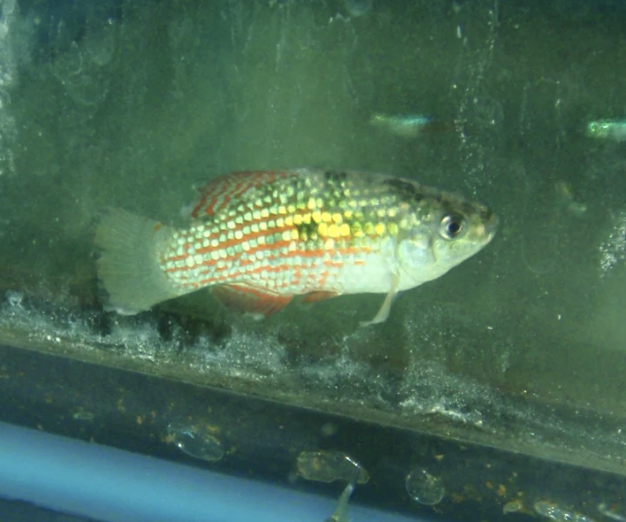 Image 1 of 1
Image 1 of 1


American Flagfish
The American Flagfish (Jordanella floridae) is a freshwater fish native to Florida, USA. They are known for their vibrant colors and distinctive pattern that resembles the American flag. Here's a care sheet to help you provide a suitable environment for your American Flagfish:
Tank Setup:
Tank Size: A 20-gallon tank is suitable for a small group of American Flagfish.
Water Parameters:
Temperature: 72-78°F (22-26°C)
pH: 6.5-8.0
Hardness: 5-20 dGH
Filtration: Use a quality aquarium filter to maintain water quality. They prefer well-oxygenated water.
Substrate: Fine gravel or sand is ideal for the substrate, as they may sift through the substrate in search of food.
Decorations:
Plants: American Flagfish appreciate a well-planted tank. Live plants like Java Fern, Anubias, and Vallisneria can be used.
Hiding Places: Provide hiding spots using decorations, rocks, or driftwood. This helps them feel secure.
Diet:
Feeding: American Flagfish are omnivores. They eat a variety of foods, including flakes, pellets, live or frozen brine shrimp, daphnia, and high-quality vegetable-based foods.
Vegetable Matter: They have a penchant for algae and may help control algae growth in the aquarium.
Tank Mates:
Compatibility: American Flagfish can be somewhat aggressive, especially males towards each other. They may also harass long-finned or slow-moving tank mates.
Tank Mate Suggestions: Suitable tank mates include other robust community fish like tetras, danios, barbs, or peaceful cichlids. Avoid keeping them with slow-moving or long-finned fish.
Behavior:
Territorial Behavior: Males can be territorial, especially during breeding. It's recommended to keep them in a ratio of one male to two or more females to disperse aggression.
Breeding: American Flagfish are known to be relatively easy to breed. Provide suitable spawning sites and maintain good water conditions. The fry are relatively large and can be fed finely crushed flakes or baby brine shrimp.
Health Considerations:
Disease Prevention: Regular water changes and proper tank maintenance are essential to prevent diseases.
Quarantine: Quarantine new fish before introducing them to the main tank to prevent the spread of diseases.
Conclusion:
By providing a well-planted tank with suitable hiding spots, a balanced diet, and proper tank mates, you can create a healthy and vibrant environment for American Flagfish. Regular observation and maintenance are key to ensuring their well-being.
The American Flagfish (Jordanella floridae) is a freshwater fish native to Florida, USA. They are known for their vibrant colors and distinctive pattern that resembles the American flag. Here's a care sheet to help you provide a suitable environment for your American Flagfish:
Tank Setup:
Tank Size: A 20-gallon tank is suitable for a small group of American Flagfish.
Water Parameters:
Temperature: 72-78°F (22-26°C)
pH: 6.5-8.0
Hardness: 5-20 dGH
Filtration: Use a quality aquarium filter to maintain water quality. They prefer well-oxygenated water.
Substrate: Fine gravel or sand is ideal for the substrate, as they may sift through the substrate in search of food.
Decorations:
Plants: American Flagfish appreciate a well-planted tank. Live plants like Java Fern, Anubias, and Vallisneria can be used.
Hiding Places: Provide hiding spots using decorations, rocks, or driftwood. This helps them feel secure.
Diet:
Feeding: American Flagfish are omnivores. They eat a variety of foods, including flakes, pellets, live or frozen brine shrimp, daphnia, and high-quality vegetable-based foods.
Vegetable Matter: They have a penchant for algae and may help control algae growth in the aquarium.
Tank Mates:
Compatibility: American Flagfish can be somewhat aggressive, especially males towards each other. They may also harass long-finned or slow-moving tank mates.
Tank Mate Suggestions: Suitable tank mates include other robust community fish like tetras, danios, barbs, or peaceful cichlids. Avoid keeping them with slow-moving or long-finned fish.
Behavior:
Territorial Behavior: Males can be territorial, especially during breeding. It's recommended to keep them in a ratio of one male to two or more females to disperse aggression.
Breeding: American Flagfish are known to be relatively easy to breed. Provide suitable spawning sites and maintain good water conditions. The fry are relatively large and can be fed finely crushed flakes or baby brine shrimp.
Health Considerations:
Disease Prevention: Regular water changes and proper tank maintenance are essential to prevent diseases.
Quarantine: Quarantine new fish before introducing them to the main tank to prevent the spread of diseases.
Conclusion:
By providing a well-planted tank with suitable hiding spots, a balanced diet, and proper tank mates, you can create a healthy and vibrant environment for American Flagfish. Regular observation and maintenance are key to ensuring their well-being.







